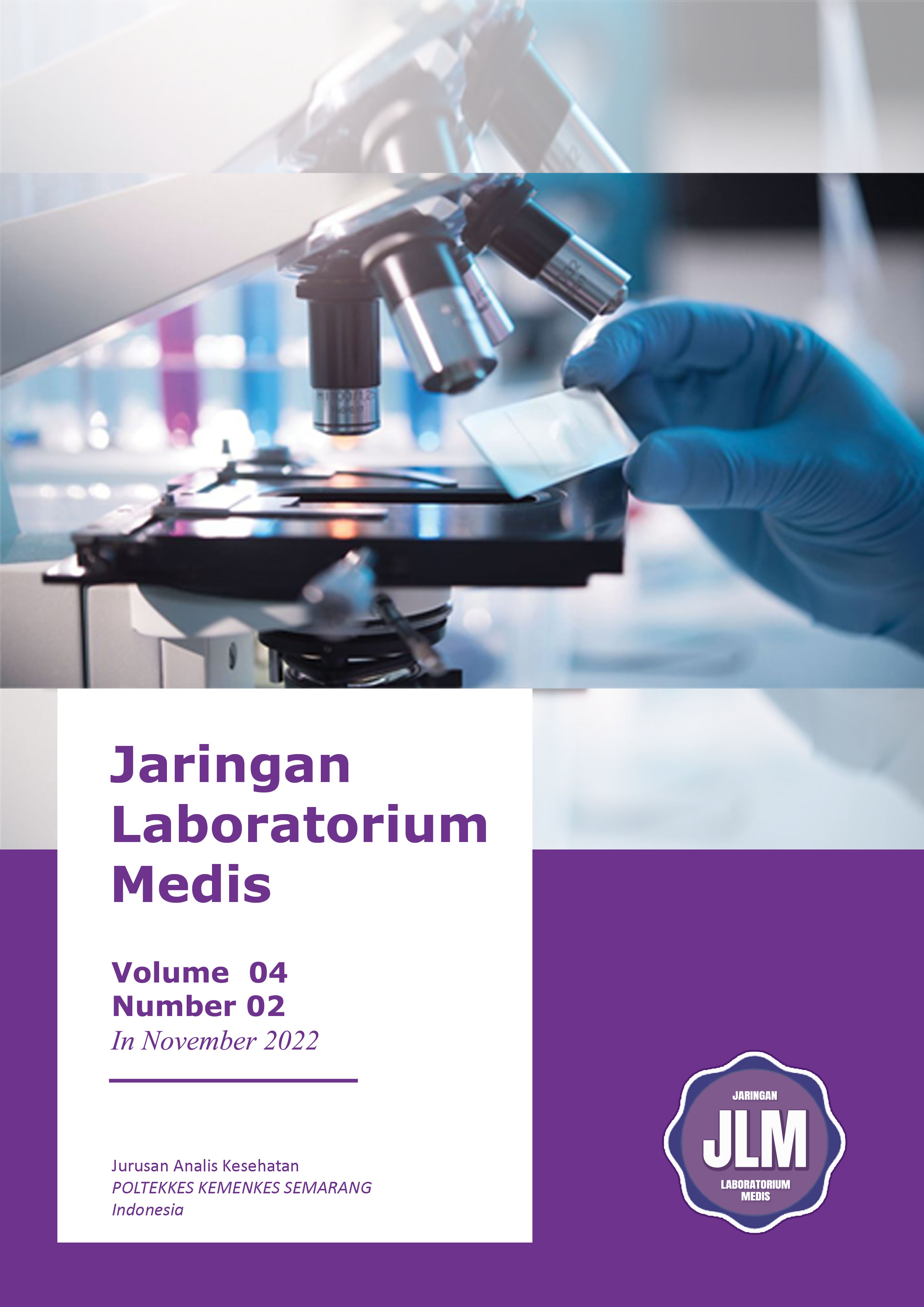Published 2022-11-01
Keywords
- Contamination,
- Vegetable,
- Leek,
- Soil Transmitted Helminths
Copyright (c) 2022 Jaringan Laboratorium Medis

This work is licensed under a Creative Commons Attribution-ShareAlike 4.0 International License.
How to Cite
CrossMark
Dimensions
If it doesn't Appear, click here
Impact Factor
Abstract
Soil Transmitted Helminths (STH) infection is still a health problem in Indonesia. This infection is caused by intestinal nematodes which in its transmission require soil media. Vegetables can be a medium of transmission of STH. STH transmission occurs when the soil is contaminated with STH worm eggs and the worm eggs stick to vegetables. In addition, STH contamination can occur in traditional markets with poor sanitation such as humid rooms, floors with lots of puddles, muddy water, and improper placement of waste. The aim of the study was to describe the contamination of Soil Transmitted Helminths on Scallion (Allium fistulosum L.). This research is a descriptive research, the examination of worm eggs is done by indirect method with sedimentation technique. The research sample was taken from 25 traders. Leeks contaminated with STH as many as 15 (60%) samples from 25 traders. The type of STH found was hookworm rhabditiform larvae. There is STH contamination in leeks sold at the Bangetayu market, Semarang City. To avoid the risk of being infected with STH, people are expected to consume vegetables that have been cooked.
Downloads
References
- Adenusi, A. A., Abimbola, W. A., & Adewoga, T. O. S. (2015). Human intestinal helminth contamination in pre-washed, fresh vegetables for sale in major markets in Ogun State, southwest Nigeria. Food Control, 50, 843–849. https://doi.org/10.1016/j.foodcont.2014.10.033
- Bekele, F., Tefera, T., Biresaw, G., & Yohannes, T. (2017). Parasitic contamination of raw vegetables and fruits collected from selected local markets in Arba Minch town, Southern Ethiopia. Infectious Diseases of Poverty, 6(1), 1–7. https://doi.org/10.1186/s40249-016-0226-6
- Dawet, Danahap, L. S., & Agbalaka. (2019). Parasitic contamination of some fruits, vegetables, and nuts sold in Jos, Plateau State, Nigeria. International Research Journal of Public and Environmental Health, 6(7), 135–143.
- Eraky, M. A., Rashed, S. M., Nasr, M. E. S., El-Hamshary, A. M. S., & Salah El-Ghannam, A. (2014). Parasitic contamination of commonly consumed fresh leafy vegetables in Benha, Egypt. Journal of Parasitology Research, 2014. https://doi.org/10.1155/2014/613960
- Fallah, A. A., Makhtumi, Y., & Pirali-Kheirabadi, K. (2016). Seasonal study of parasitic contamination in fresh salad vegetables marketed in Shahrekord, Iran. Food Control, 60(1), 538–542. https://doi.org/10.1016/j.foodcont.2015.08.042
- Faour-Klingbeil, D., Murtada, M., Kuri, V., & Todd, E. C. D. (2016). Understanding the routes of contamination of ready-to-eat vegetables in the Middle East. Food Control, 62, 125–133. https://doi.org/10.1016/j.foodcont.2015.10.024
- Heredia, N., & García, S. (2018). Animals as sources of food-borne pathogens: A review. Animal Nutrition, 4(3), 250–255. https://doi.org/10.1016/j.aninu.2018.04.006
- Kemenkes RI. (2017). Permenkes RI Tentang Penanggulangan Cacingan (The Minister of Health of the Republic of Indonesia concerning the Prevention of Worms) (pp. 1–78). pp. 1–78. Jakarta: Kementerian Kesehatan RI.
- Kemenkes RI. (2020). Permenkes RI No 17 Tahun 2020 Tentang Pasar Sehat. Kemenkes RI, Vol. 5, p. 55.
- Punsawad, C., Phasuk, N., Thongtup, K., Nagavirochana, S., & Viriyavejakul, P. (2019). Prevalence of parasitic contamination of raw vegetables in Nakhon Si Thammarat province, southern Thailand 11 Medical and Health Sciences 1117 Public Health and Health Services. BMC Public Health, 19(1), 1–7. https://doi.org/10.1186/s12889-018-6358-9
- Radman, P., Gložinić, M., Marček, T., Čorluka, S., Banjari, I., Ižaković, M., Sučić, M. (2018). a Comparative Survey on the Prevalence of Parasite Elements in Fresh Vegetables and Ready-To-Eat Salads. Hrana U Zdravlju I Bolesti : Znanstveno-Stručni Časopis Za Nutricionizam I Dijetetiku, 7(2), 26–30.
- Safitri, O. W., & Wikandari, R. J. (2019). Gambaran Infeksi Telur Cacing Soil Transmitted Helminths Pada Petani Bunga Profile of Transmitted Helminths Soil Worm Egg Infection in Flower Farmers. Jaringan Laboratorium Medis, 1(2), 86–90. https://doi.org/10.31983/jlm.v1i2.5883
- Sitepu, R. (2019). The Difference of Soil Transmitted Helminths (STH) on Vegetables in Traditional and Modern Markets. IJEMS:Indonesian Journal of Education and Mathematical Science, 1(2), 43. https://doi.org/10.30596/ijems.v1i2.5242
- WHO. (2019). Soil-Transmitted Helminth Infections. Retrieved from WHO Press website: https://www.who.int/news-room/fact-sheets/detail/soil-transmitted-helminth-infections
- Wikandari, R. J., Qomariyah, N., Budiharjo, T., & Djamil, M. (2019). Deteksi Cacingan Melalui Pemeriksaan Feses Dan Kuku Pada Anak Panti Asuhan Kyai Ageng Fatah Pedurungan. Link, 15(1), 32. https://doi.org/10.31983/link.v15i1.4399
- World Health Organization. (2015). Assesing The Epidemiology of STH During TAS. In Assesing The Epidemiology of STH During TAS (pp. 1–44). Geneva: World Health Organization.


